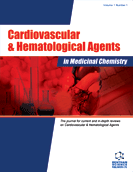Abstract
Background: The absolute oral bioavailability of rosuvastatin (RST), a secondgeneration statin, is low i.e. 20% and only 10% is recovered as metabolite N-desmethy l rosuvistatin. Since it is a hydrophilic statin, RST relies on the organic anion transporting polypeptide- 1B1 (OATP-1B1), as the key mechanism for active transport into hepatocytes. Quercetin (QUE) being a bio enhancer and inhibitor of OATP1B1 can augment the bioavailability and pharmacokinetics of RST.
Objective: The present study includes the development of a simple and validated bioanalytical Reverse Phase High-Performance Liquid Chromatography (RP-HPLC) method for the estimation of RST and to study the effect of co-administration of QUE as a bio enhancer on its bioavailability.
Method: An analytical column of Kromasil 100, C18 (250 mm × 4.6 mm, 5 μm), was used for chromatographic separationand acetonitrile (ACN): acetic acid buffer pH 3.0 adjusted with glacial acetic acid (55:45 Vol. %) as mobile phase with flow rate 1.0 ml/min monitored at 242 nm. The ACN: methanol (50:50 Vol. %) was employed as the final solvent for extraction. The developed method has been successfully applied in a study on the pharmacokinetics of the drug RST in rats after co-administration of QUE, which was carried out using non-compartmental analysis in order to estimate the blood concentration of the drug.
Results: The pharmacokinetics of RST was found to be altered significantly (highest concentration
of RST in the blood (Cmax) = 67.3 ng/ml to 122.2 ng/ml) (p < 0.001), area under curve
(AUC)0-t (p < 0.0001) and AUC0-inf (p = 0.0005) when co-administered with QUE at 120 min
(tmax).
Conclusion: The results are in accordance with the fact that QUE increases plasma levels in rats
through herb-drug interactions.
Animated Abstract
[http://dx.doi.org/10.1111/j.1527-3466.2002.tb00099.x] [PMID: 12481202]
[http://dx.doi.org/10.1016/j.ics.2003.12.099]
[http://dx.doi.org/10.2165/00003088-199732050-00005] [PMID: 9160173]
[http://dx.doi.org/10.1592/phco.26.4.469] [PMID: 16553504]
[http://dx.doi.org/10.4137/CMC.S4324] [PMID: 22442638]
[http://dx.doi.org/10.1016/S0149-2918(03)80336-3] [PMID: 14693307]
[http://dx.doi.org/10.1016/S1567-5688(03)00004-7] [PMID: 12714032]
[http://dx.doi.org/10.1016/j.clpt.2004.03.010] [PMID: 15289793]
[http://dx.doi.org/10.1046/j.1365-2125.2002.01688.x] [PMID: 12445025]
[http://dx.doi.org/10.1016/j.colsurfb.2013.08.025] [PMID: 24012665]
[http://dx.doi.org/10.1016/j.ejpb.2016.10.022] [PMID: 27810472]
[http://dx.doi.org/10.1039/C5RA24278A]
[http://dx.doi.org/10.1080/1061186X.2016.1191080] [PMID: 27186665]
[http://dx.doi.org/10.1100/2012/637953]
[http://dx.doi.org/10.1111/j.1365-2125.2011.04150.x] [PMID: 22114872]
[http://dx.doi.org/10.3390/nu12082306]
[http://dx.doi.org/10.5958/0974-360X.2020.00368.6]
[http://dx.doi.org/10.4314/tjpr.v13i9.26]
[http://dx.doi.org/10.1016/j.ejmech.2018.06.053] [PMID: 29966915]
[http://dx.doi.org/10.1016/j.neuint.2015.07.002] [PMID: 26160469]
[http://dx.doi.org/10.1038/aps.2013.202] [PMID: 24786236]
[http://dx.doi.org/10.1016/j.bcp.2012.05.011] [PMID: 22634047]
[http://dx.doi.org/10.1007/s12272-012-1017-7] [PMID: 23139136]
[http://dx.doi.org/10.1016/j.ejps.2009.09.018] [PMID: 19804821]
[http://dx.doi.org/10.1016/S0024-3205(02)02235-X] [PMID: 12427482]
[http://dx.doi.org/10.1002/bdd.1847] [PMID: 23625744]
[http://dx.doi.org/10.1016/j.ijpharm.2006.01.028] [PMID: 16516418]
[http://dx.doi.org/10.7324/JAPS.2019.90111]
[http://dx.doi.org/10.1016/j.synres.2018.09.001]
[http://dx.doi.org/10.1080/00498254.2018.1478168] [PMID: 29768080]
[http://dx.doi.org/10.3109/00498254.2015.1132792] [PMID: 26928207]
[http://dx.doi.org/10.3109/03639045.2012.707209] [PMID: 22817837]
[http://dx.doi.org/10.1592/phco.26.9.1255] [PMID: 16945047]
[http://dx.doi.org/10.1177/0091270005278407] [PMID: 16027405]
[http://dx.doi.org/10.1016/j.ijpharm.2004.12.004] [PMID: 15907592]
[http://dx.doi.org/10.1211/0022357044814] [PMID: 15563760]
[http://dx.doi.org/10.1053/j.gastro.2006.02.034] [PMID: 16697742]
[http://dx.doi.org/10.1016/j.microc.2018.07.021]




























